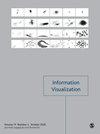Visualizing the invisible: User-centered design of a system for the visualization of flows and concentrations of particles in the air
IF 1.8
4区 计算机科学
Q3 COMPUTER SCIENCE, SOFTWARE ENGINEERING
引用次数: 1
Abstract
This study presents two experiments addressing the representation of scientific data, in particular airflows, with a user-centered design approach. Our objective is to provide users feedback to data visualization designers to help them choose an air flow representation that is understandable and attractive for non-experts. The first study focuses on static markers allowing to visualize an airflow, with information characterizing the direction and the intensity. In a second study, carried out in an immersive virtual environment, two information were added, the temporal evolution and the concentration of pollutants in the air. To measure comprehension and attractiveness, participants were asked to answer items on Likert scales (experiment 1) and to answer User Experience Questionnaire (experiment 2). The results revealed that arrows seem to be a very common and understandable form to represent orientation and direction of flow, but that they should be improved to be more attractive by making them brighter and more transparent, as the representation could occlude the scene, especially in virtual reality. To solve this problem, we suggest giving the users the ability to define the specific area where they want to see the air flow, using a cross-sectional view. Vector fields and streamlines could therefore be applied in a virtual reality context.可视化看不见的:以用户为中心的系统设计,用于可视化空气中颗粒的流动和浓度
本研究提出了两个实验解决科学数据的表示,特别是气流,以用户为中心的设计方法。我们的目标是向数据可视化设计师提供用户反馈,帮助他们选择对非专家来说容易理解和有吸引力的气流表示。第一项研究侧重于静态标记,使气流可视化,并提供表征方向和强度的信息。在第二项研究中,在沉浸式虚拟环境中进行,增加了两个信息,即时间演变和空气中污染物的浓度。为了测量理解和吸引力,参与者被要求回答李克特量表(实验1)和用户体验问卷(实验2)的问题。结果表明,箭头似乎是一种非常常见和可理解的形式,以表示方向和流量,但他们应该改进,使其更明亮和更透明,以更具吸引力,因为这种表示可能会遮挡场景,特别是在虚拟现实中。为了解决这个问题,我们建议让用户能够使用横截面视图来定义他们想要看到气流的特定区域。因此,矢量场和流线可以应用于虚拟现实环境中。
本文章由计算机程序翻译,如有差异,请以英文原文为准。
求助全文
约1分钟内获得全文
求助全文
来源期刊

Information Visualization
COMPUTER SCIENCE, SOFTWARE ENGINEERING-
CiteScore
5.40
自引率
0.00%
发文量
16
审稿时长
>12 weeks
期刊介绍:
Information Visualization is essential reading for researchers and practitioners of information visualization and is of interest to computer scientists and data analysts working on related specialisms. This journal is an international, peer-reviewed journal publishing articles on fundamental research and applications of information visualization. The journal acts as a dedicated forum for the theories, methodologies, techniques and evaluations of information visualization and its applications.
The journal is a core vehicle for developing a generic research agenda for the field by identifying and developing the unique and significant aspects of information visualization. Emphasis is placed on interdisciplinary material and on the close connection between theory and practice.
This journal is a member of the Committee on Publication Ethics (COPE).
 求助内容:
求助内容: 应助结果提醒方式:
应助结果提醒方式:


